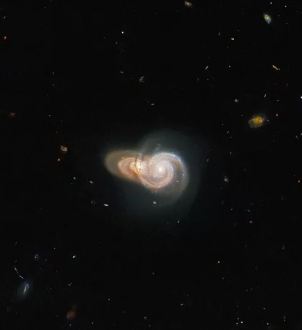A recent image from NASA’s venerable space telescope shows two distant spiral galaxies that appear to be “overlapping.” Hubble Telescope Spiral Galaxies

The galaxies are more than a billion light-years away from Earth and are referred to as SDSS J115331 and LEDA 2073461. The European Space Agency (ESA), a partner in the observatory, said that while the new Hubble Space Telescope picture appears to show the two galactic entities merging, it is only an optical illusion and the galaxies aren’t truly interacting with one another at all.
Hubble Telescope Spiral Galaxies
The alignment of the two galaxies is probably merely by chance; the two are not truly interacting, according to ESA officials, despite the fact that they look to clash in the image. Hubble has already photographed a stunning array of interacting galaxies, whereas these two galaxies might just be passing ships in the night.
The two galaxies’ accidental alignment, as viewed by Hubble, provides a breathtaking frontal picture of the nearby galaxy with its spiral arms spread out on either side.
The most recent image, which ESA posted on September 5, was produced using observations from the Galaxy Zoo project of the space agency. The goal of this citizen science project, which has thousands of volunteers, is to crowdsource galaxy classifications. It started in 2007.
According to ESA officials, “these volunteers classify galaxies seen by robotic telescopes and are frequently the first to ever set eyes on an astronomical object.”
Hubble Telescope Spiral Galaxies
The Galaxy Zoo project’s participants have actually aided in the discovery of a wide variety of intriguing cosmic phenomena, from rare three-armed spiral galaxies to colliding ring galaxies. According to the announcement, Hubble chooses its research targets by a popular vote.





















